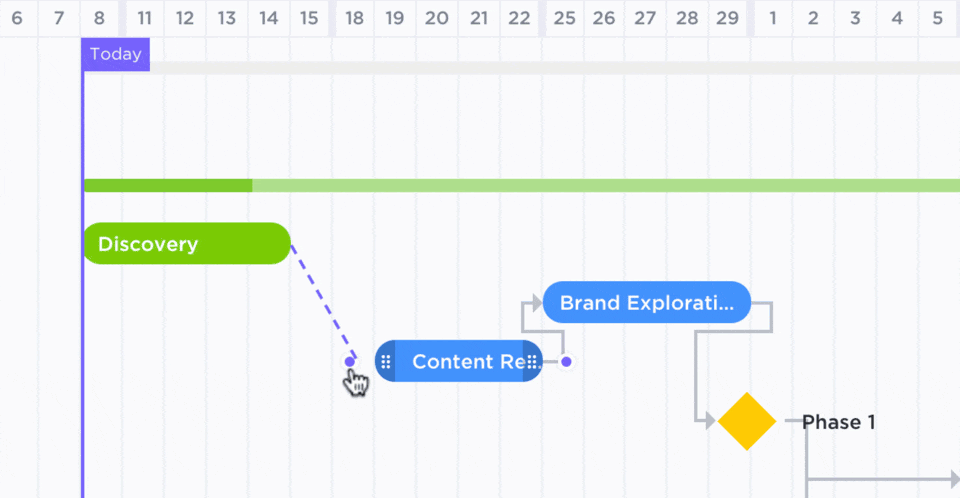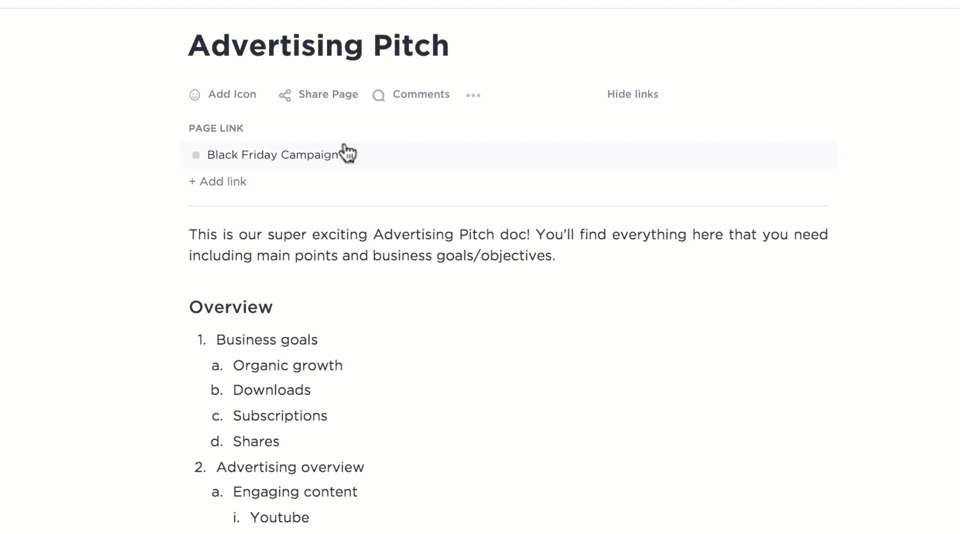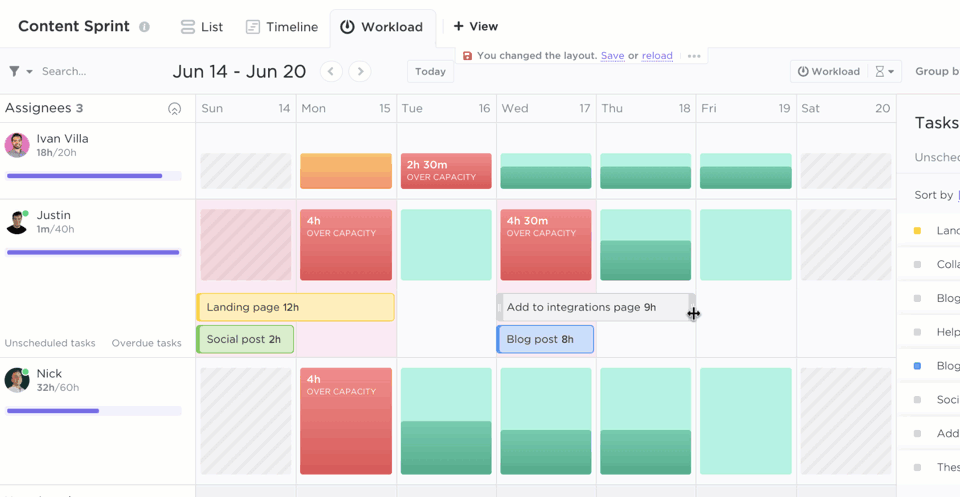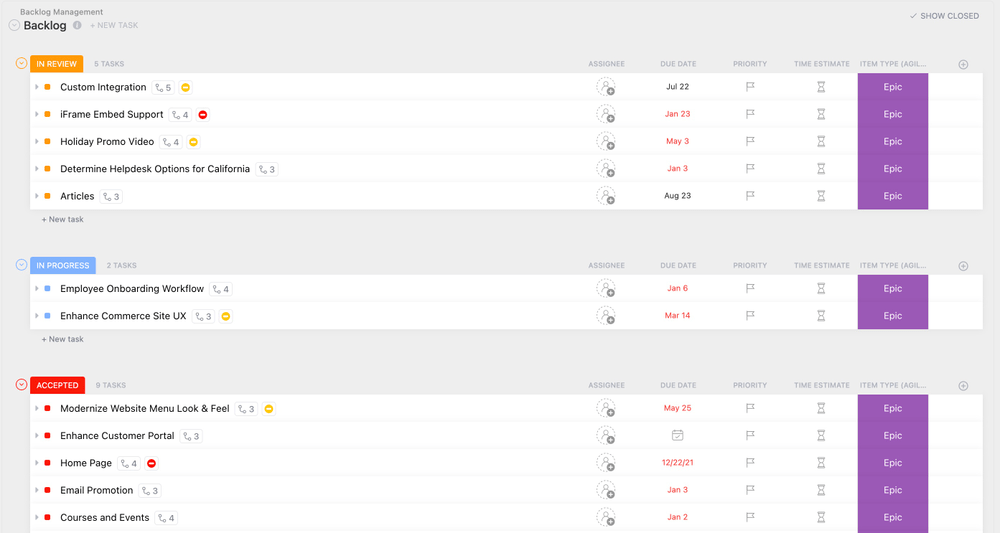The Sprint Planning Guide for Agile Project Managers

Sorry, there were no results found for “”
Sorry, there were no results found for “”
Sorry, there were no results found for “”
With agile transformations on the rise, sprint planning continues to grow in popularity—often with compelling results. Companies gain flexibility, solve big problems, and have built-in pauses between developments where they can assess progress and recalibrate as necessary.
If you’re new to sprint planning, here’s everything you need to know. And if you’re not new and just need some project management software to get you started? We’ve got you covered—for free—with ClickUp’s Sprint and agile features.
Sprint planning is the process of identifying what you want to achieve in a sprint (your goals) and how you will achieve it (the plan) in your next sprint—based on business goals, your product backlog, and team capacity and velocity. Your sprint planning meeting should set expectations, give teams direction, and ensure everyone is on the same page before each sprint.
WAIT A SECOND… WHAT IS A SPRINT?
If you’re brand new to agile, here’s a quick primer: a sprint is a short timeframe (most commonly two weeks, though one-week and four-week sprints do exist) in which your team plans to deliver something.
The idea behind sprinting is rather than planning your development team’s whole year out and leaving no room for creativity, innovation, market shifts, or emergencies, you plan for the delivery of priority items on a short timeline. This leaves room for growth and shifting priorities. It also means teams are constantly delivering priority features or products and as priorities shift, so too can what your teams are working on.
So, why are so many companies sprinting these days? What exactly does the practice do for your teams, your customers, and your company’s bottom line? The answers are pretty appealing:
The core idea behind sprinting is this: short, well-defined work periods mean faster delivery and more flexibility. They let teams turn big projects into smaller, more manageable milestones and give leadership pre-defined checkpoints where you can pivot, re-prioritize, or even nix projects based on new information like business goal shifts or major market changes.

The clearer (and more flexible) your plan is, the easier it is for teams to collaborate effectively to get things done. And the built-in pauses as you finish one sprint and begin the next give teams automatic check-in points.
PRODUCTIVITY TIP
Psst…25% of ClickUp customers said they switched to our platform because they needed better collaboration tools—and 91% say collaboration improved after making the switch.
By providing clear direction on goals, milestones, team responsibilities, and expected value, sprint planning takes the guesswork out of our processes. This means less time spent asking big-picture questions mid-project (reducing delays) and less space for incorrect guesses about what leadership wants (reducing duplicate work).
Nobody wants to spend their work time being uncertain about what they need to deliver, by when, or how their success will be defined. It’s stressful and takes creative energy away from solving actual work problems.
With a clear, manageable list of project deliverables and a finite, reasonable timeline (weeks instead of months), teams don’t have to guess about their priorities, expected outcomes, or what they should be working on. This reduces stress and mental overhead (the amount of info people hold in their minds to do their work), which also contributes to productivity.
The better we document our plans, the better we can learn from them. What worked well? What didn’t work at all? What roadblocks did we hit that we could avoid in the future?

Short sprints mean we’re asking these questions more often (and learning from them more often as well). Well-defined plans and well-documented sprints mean clearer answers when we do ask these questions. And strategic iteration means constant improvement (and less getting stuck in old habits).
Sprint planning should happen before your sprint and after the backlog refinement, sprint review, and sprint retrospective from your previous sprint (where you’ll learn what practices teams should duplicate or ditch from the prior sprint).

Typically, sprint planning meetings last about one hour for each week of the sprint. (E.g. if you do two-week sprints, your meeting should be about two hours. If you do three-week sprints, plan for a three-hour block of time.)
That said, there are ways to keep your sprint planning shorter and sweeter. Companies need to keep their backlog refined and ask leadership to come into the meeting with a well-defined plan.
This allows leadership to set priorities, reducing meetings to 30 minutes, so they can solely focus on feature flagging anything that won’t be completed/hasn’t been completed in the current sprint. Afterward, the team can review the proposed priorities from the (clean, refined) backlog and get team consensus.
As with any meeting, the shorter the better. Research suggests that the average attention span is just 10 to 18 minutes (which is why TED Talks are 18 minutes or less). While we doubt that you’ll get your planning sessions down quite that low, do look for ways to trim the fat.
TIPS TO KEEP MEETINGS SHORTER
Setting a timer, having people take notes by hand (not on laptops), checking cell phones at the door, and planning silence into your meetings (yes, really!) are just a few of the things successful teams do to keep meetings from running long, according to FastCompany.
If you plan to do something unorthodox like banning cell phones or taking away chairs, make sure you have a plan for accessibility for your disabled employees. Some people must sit and others may need their phones for medical alerts.
While the whole development team should be part of your planning meeting, the primary planners here are your Scrum master, product owner, and engineering manager.
The Scrum master leads the Scrum team and makes sure they have what they need going into the new sprint (setting them up for success). The product owner is the keeper of your product vision and your product backlog.
They should be in close touch with the client and are responsible for developing and updating the product backlog. The engineering manager should be involved in any scoping or alignment in advance of the meeting.
Also—notably—sprinting isn’t just for your development teams. McKinsey suggests implementing agile transformations in sprints. And Harvard Business Review says sprints are for solving big problems. The usefulness of thinking and planning in short bursts—for more than one kind of team—has been proven over and over again by industry leaders and top business research institutions.
ClickUp Goals: Once your product owner has set your goals, the sprint planning meeting is the time to make sure the team is in the loop. The better they understand what they’re aiming for, the more successful each sprint will be.

Backlog selection: Preferably before the sprint planning meeting, your product owner will have prioritized the backlog, and during the meeting, they’ll communicate those priorities to the teams.
STRUGGLING TO KEEP YOUR BACKLOG ORGANIZED?
Try ClickUp’s lists! Not only can you gather your backlog items in one place and order the tasks attached to them, but you can also nestle each list item within specific project folders, add relevant info to each list item (owners, attachments, etc.), sort tasks by status, and drag and drop tasks easily to change status. Easy, real-time updates make these lists a huge asset during your planning meeting.
Velocity: How fast are your teams? The better you can answer this question (on a team-by-team basis), the better you can plan. Use past sprints to calculate team velocity for future sprints and during the planning meeting, check-in. Do teams think this project might require a longer or shorter timeline? Use the meeting to get their input and avoid under or over-scheduling.
Capacity: Speaking of under or over-scheduling, capacity is the other metric you should be planning for. To determine this, you need to know what the team (or each team member) has on their plate already, what can and cannot be pushed, and how your priority intersects with their existing priorities. (Psst…ClickUp’s Workload view can help with this.)

When determining capacity, many teams use a system like sprint points, which allows you to assign several points that teams can tackle in a set period and then assign each task a point value to see how it fits into the overall total capacity.
It’s worth noting that capacity planning shouldn’t just be about figuring out due dates. It’s about aligning teams on the scope and the effort required to get something done. The points system helps identify any big discrepancies in understanding.
If one engineer says the effort required is two points and another says it’s seven, you know someone is missing something. This can help you surface dependencies and clarify assumptions before the sprint begins.
Dependencies: Cross-team dependencies should be a part of your pre-sprint planning and should come up during the meeting to ensure you have them all mapped out (the last thing you want is to discover a huge last-minute dependency that takes the plan off the rails).

Tasks: How will we reach the goal we’ve set? What are the tasks, milestones, and order of operations we’ll need to complete? Who is assigned to which task and how will they get it done? Your project manager should already have a project management timeline with answers to these questions. Use your meeting time to tweak as needed if your team brings in new information, time estimates, etc.
Metrics: Finally, make sure your meeting answers a key question: how will you know if you’re successful? What metrics will you judge the sprint’s effectiveness by? What exactly should teams and individuals be aiming for?

So, you know what a sprint planning meeting is, when to have it, who’s in charge, and what it covers. Now, make it even better with some tips from experts:
Nobody likes long meetings. Even important ones. This means if you want your meeting to pack a maximum punch and face less resistance, project managers and leadership need to do the work up-front to keep the actual meeting as short and simple as possible.
Speaking of keeping things short and clear, the cleaner your agenda, the faster (and better) your meeting will go. Know what you need to talk about, in what order, and with what priority. And lead with the things that require the greatest focus.
As Simon Sinek (of TED Talk fame) says: “people don’t buy what you do; they buy why you do it.” He’s primarily talking about customers, but the same goes for internal teams. If you want them to buy into a project and put their all into it, they need to know why it matters. What goals are they working toward and how do those goals impact customer or employee lives for the better?
Project managers and team leads should make it as easy as possible for the team to say yes to the plan. Don’t use your meeting as a brainstorming session or overburden teams with figuring out the roadmap on their own. Come in with clear suggestions and let the team give useful feedback instead. This is the most efficient use of time and doesn’t steal focus or creative energy from your teams.
What does a successful planning session look like? What do you want teams to walk away knowing? What clarifying questions do you need to get answered? Does the team release at the end of this sprint and how does that impact your planning? You should walk into the meeting already knowing not only what a successful sprint will look like, but also what a successful planning meeting should look like at the end.
With burnout and turnover reaching alarming rates, it’s more important than ever to be realistic about what teams and individuals can achieve. Use past velocity to make your plan, but also listen when teams tell you they’ll need more time or are struggling to reach your goals.
For many teams, setting a realistic, achievable goal and a stretch goal with extra incentives can help ensure teams aren’t burning the candle at both ends but are reaching for big things.
Each sprint should inform the sprints that come after it. What did teams do well (and is duplicable)? What needs some work? What did you learn from past sprints? How can you apply it to the future? Regular retrospectives can help you get the answers and fold them into the next planning session.
Try out these retrospective tools!
PRO TIP
Want more advice? Check out this collection of agile project management tips from 20+ experts.
Sprint planning is a lot of strategic work—and having the right tools is paramount. (We know we’re biased, but with a whopping 96% of our customers saying they’re more efficient after adopting our tools, we think the jury is solidly in agreement).
Here are three ClickUp agile templates that might come in handy for your sprint planning meeting:

The ClickUp Agile Project Management Template allows you to view progress at a glance, track sprints, and customize statuses to meet your teams’ unique needs.

From backlogs to sprints to retrospectives, this ClickUp Agile Scrum Management Template puts all the sprint planning elements you need in one, easy-to-view, easy-to-edit place.

Running a retrospective after one sprint and before the next? The ClickUp Sprint Retrospective Brainstorm Template has everything you need.
Bonus: Sprint Retrospective Templates
ClickUp’s free Sprint and agile tools are designed to help product owners and Scrum leaders pre-plan, run sprint planning meetings, and keep track of the ever-changing landscape of each project. And with the help of ClickUp, your team can do just that.
Try it for free to see why so many dev teams are moving to ClickUp to manage sprint planning and retrospectives.
© 2025 ClickUp